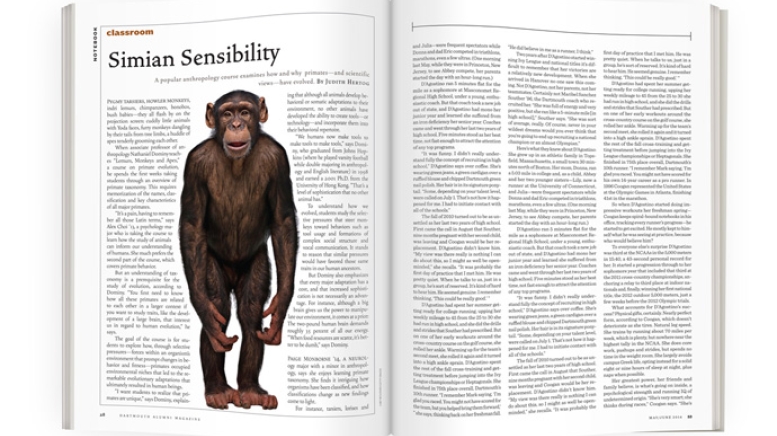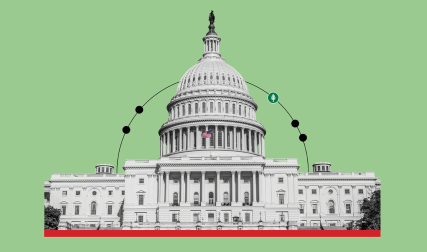Pygmy tarsiers, howler monkeys, indri lemurs, chimpanzees, bonobos, bush babies—they all flash by on the projection screen: cuddly little animals with Yoda faces, furry monkeys dangling by their tails from tree limbs, a huddle of apes tenderly grooming each other.
When associate professor of anthropology Nathaniel Dominy teaches “Lemurs, Monkeys and Apes,” a course on primate evolution, he spends the first weeks taking students through an overview of primate taxonomy. This requires memorization of the names, classification and key characteristics of all major primates.
“It’s a pain, having to remember all those Latin terms,” says Alex Choi ’13, a psychology major who is taking the course to learn how the study of animals can inform our understanding of humans. She much prefers the second part of the course, which covers primate behavior.
But an understanding of taxonomy is a prerequisite for the study of evolution, according to Dominy. “You first need to know how all these primates are related to each other in a larger context if you want to study traits, like the development of a large brain, that interest us in regard to human evolution,” he says.
The goal of the course is for students to explore how, through selective pressures—forces within an organism’s environment that prompt changes in behavior and fitness—primates occupied environmental niches that led to the remarkable evolutionary adaptations that ultimately resulted in human beings.
“I want students to realize that primates are unique,” says Dominy, explain-ing that although all animals develop behavioral or somatic adaptations to their environment, no other animals have developed the ability to create tools—or technology—and incorporate them into their behavioral repertoire.
“We humans now make tools to make tools to make tools,” says Dominy, who graduated from Johns Hopkins (where he played varsity football while double majoring in anthropology and English literature) in 1998 and earned a 2001 Ph.D. from the University of Hong Kong. “That’s a level of sophistication that no other animal has.”
To understand how we evolved, students study the selective pressures that steer monkeys toward behaviors such as tool usage and formations of complex social structure and vocal communication. It stands to reason that similar pressures would have favored those same traits in our human ancestors.
But Dominy also emphasizes that every major adaptation has a cost, and that increased sophistication is not necessarily an advantage. For instance, although a big brain gives us the power to manipulate our environment, it comes at a price: The two-pound human brain demands roughly 35 percent of all our energy. “When food resources are scarce, it’s better to be dumb,” says Dominy.
Paige Monborne ’14, a neurology major with a minor in anthropology, says she enjoys learning primate taxonomy. She finds it intriguing how organisms have been classified, and how classifications change as new findings come to light.
For instance, tarsiers, lorises and lemurs were originally classified as primitive primates (prosimians), while monkeys and apes were classified as anthropoids. That whole distinction was overthrown when in 2011 it was determined that tarsiers—tiny, saucer-eyed southeast-Asian primates—are genetically closer to monkeys and apes than to other primitive primates and probably share a common ancestor with humans. Tarsiers have changed so little in the past 40 million years that they still look very similar to this common ancestor and can be considered “living fossils,” Dominy says. Instead of making a distinction between primitive and evolved primates, the new taxonomy divides primates into haplorhini (dry-nosed primates) and strepsirrhini (wet-nosed primates), because it is the dry nose that distinguishes tarsiers, monkeys and apes from other primates.
Dominy wants students to understand that such revisions to previous assumptions are part of science, which is always evolving—and to learn to speculate scientifically about the evolution of organisms by analyzing their behavior and physiology.
One example of such speculation is the case of the howler monkey, one of the loudest animals on earth. Dominy suggests that their noisiness may be linked to their inefficient digestive system: Most animals that eat leaves need to have long guts to digest the tough fibers in their diet. Monkeys found in the Western Hemisphere were too small to develop the lengthy guts necessary to eat leaves, so they turned to other foods. Only howler monkeys occupied the leaf-eater niche. Their notorious laziness and vociferousness may be an indirect result of their inefficiency at extracting nutrition from their diet, Dominy speculates: The monkeys move as little as possible to preserve energy, and in order not to waste energy in fights, they scare away enemies with their deafening howls. It’s an interesting theory.
In his own research, Dominy looks at fossil records and the physiology and the behavior of existing species to analyze how the senses of primates evolved to locate, identify and hunt for food. Dominy says he’s interested in food because all of evolution hinges on it. “The first, most important concern for living organisms is to avoid becoming food themselves,” he says. “If they’re good enough to do that, they can focus on finding food, and if they can do that, then they can have sex and reproduce. Ultimately, that’s all there is to it.”
The 36-year-old professor keeps in his office a copy of a 1985 National Geographic issue that features a hologram image of a humanoid skull on its cover. It was the first research he read about human evolution, he recalls. Dominy now knows many of the researchers quoted in the article. As he flips through the pages he points at a picture of a biologist. “I just got an e-mail from him this morning,” he says with a grin.
The question asked in that National Geographic is still unanswered: Why did some apes start walking upright and develop the sophisticated intelligence that ultimately made them the ancestors of early humans? One current theory is that natural selection favored apes with a high propensity for cooperative behavior, a form of social intelligence. Current studies of chimpanzee behavior have found that the more cooperative chimpanzee communities are the most successful at waging war against rival communities. So it is plausible that those of our ancestors who formed the most sophisticated social bonds were able to spread out because they had an advantage when confronting other groups.
This theory seemed particularly relevant when Philip Gourevitch, a New Yorker staff writer who has covered the Rwandan genocide, visited the course as a Montgomery guest lecturer in July. Gourevitch was an anthropology major at Cornell, and he worked briefly as a teaching assistant for Dian Fossey, author of the 1983 best-selling Gorillas in the Mist. Gourevitch argued that although extreme violence at the level of genocide is often described as “inhumane” or “a crime against humanity,” it is actually uniquely human. No other animal possesses the sophistication to carry out the systematic, large-scale level of violence that humans use against each other, he said.
Steven Tebbe ’13, a double major in anthropology and geography, says he was intrigued by Gourevitch’s lecture because he wants to understand the degree to which human behavior and human violence are determined by biology. “If we compare ourselves to our closest genetic relatives,” Tebbe asks, “what is inherent and what is culture or circumstance or environment?”
Dominy cautions against drawing too close a parallel between human and non-human primate behavior. In one course lecture he describes how one of his colleagues at Harvard published a popular book explaining male aggression in terms of chimpanzee behavior. He then turns to the class and asks, “So, ladies, how do you feel about this?”
“If you can explain male behavior that way, you can do the same with female behavior,” says Monborne.
“Exactly,” says Dominy. “And we humans are supposed to have control over our behavior. We can’t be reduced to a bunch of biological imperatives.”
Recommended Reading
Primate Adaptation and Evolution, by John Fleagle (Academic Press, second edition, 1998). Technical but highly accessible textbook on primate evolution. A classic.
Primate Behavioral Ecology, by Karen B. Strier, (Pearson, fourth edition, 2010). The most widely used textbook on primate behavior. Thorough.
Among Orangutans: Red Apes and the Rise of Human Culture, by Carel van Schaik and Perry van Duijnhoven (Belknap Press of Harvard University, 2004). A popular book that stands alone for its integration of ecology, behavior and anthropology. Accessible and richly illustrated.
The Ape in the Tree, by Alan Walker and Pat Shipman (Belknap Press of Harvard University, 2005). An entertaining book about personal discovery and controversy in the field of primate evolution.
How Monkeys See the World, by Dorothy L. Cheney and Robert M. Seyfarth (University of Chicago Press, 1992). A fascinating account of how clever experiments in the wild can reveal how monkeys think. Insightful.
Judith Hertog is a frequent contributor to DAM. She lives in Norwich, Vermont.




